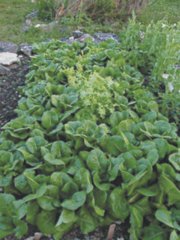Confident gardeners will have some seeds in the ground already for the new vegetable growing season. Sweet peppers benefit from an early start and tomatoes set fruit at the end of October, so a plant started now will be flowering by then.
Plants produce most of the nutrients they need (about 90%) from the process of photosynthesis. The remaining nutrients they require are in the form of soluble mineral salts, what we call commercial fertilizer. When we buy fertilizer the package will have a three-number indicator such as 6-8-4. These numbers refer to the percentage of the main mineral salts required by plants: nitrogen (N), phosphorus (P), and potassium (K). Palm fertilizers often add the next two important elements, magnesium (Mg) and manganese (Mn).
All fertilizers contain a number of trace elements that are required by plants but only in very small amounts. The full list includes the five elements I have already mentioned plus calcium, zinc, chlorine, copper, molybdenum, sulphur, boron and iron.
The general theory is that you dig over your soil, add fertilizer, sow your seeds, water regularly, weed, and wait for your harvest. There is one little problem, however. Bahamian soil is made from calcareous sources and is very alkaline. Alkaline soil tends to ‘tie up’ or prevent fertilizers from performing as they should.
Lemon juice is very acid and that stuff we buy to pour into blocked up sinks is very alkaline. Right in the middle is distilled water. A Danish chemist named Serenson worked out a scale to measure the relative acidity and alkalinity of substances using a measure of the activity of the solvated hydrogen ion. This is called the pH (pee- aitch) scale and runs from 0 to 14. The H stands for hydrogen. Nobody knows what the p stands for.
On the pH scale we would find that gastric acid is 1, orange juice 3, black coffee 5, distilled water 7, baking soda 9, ammonia solution 11, and bleach 13. Soils tend to run from 4.5 to 8.5.
The problem for Bahamian gardeners is to amend the soil so it approaches a pH of 7.0, where fertilizers can be fully productive. This can be done by adding quantities of organic matter, such as peat moss and compost. The addition of sulphur in the form of ‘flowers of sulphur’, a yellow dust, will help bring down the alkalinity of our soil.
Fertilizers come in several forms: granulated, crystallized, and time release. Granulated fertilizer should be dug into the soil ahead of sowing time and surface applications made at monthly intervals thereafter. Crystallized fertilizers are made to be water-soluble and are usually applied using a hose-end applicator. Time-release fertilizers should also be dug in before seeds or transplants are planted but should not need applications of side dressings.
It was discovered in 2007 that no plant will grow unless it contains vitamin C. Plants tend to make their own vitamins but some farmers have developed the custom of adding vitamins to their fertilizers and swear this makes a difference in plant growth. The study of how vitamins affect plant growth is in its infancy and there is much in the way of speculation.
There is a commercial brand of vitamin additives for plants named Superthrive. Many of my gardening colleagues swear by it. The dosage is one drop of Superthrive to one gallon of water.
Whether the addition of vitamins to fertilizer helps plants at all is questionable. Maybe it only works if you believe in it.
• j.hardy@coralwave.com





Comments
Use the comment form below to begin a discussion about this content.
Sign in to comment
Or login with:
OpenID